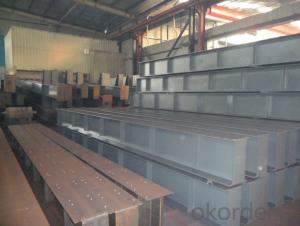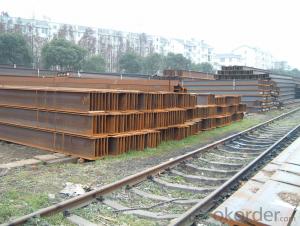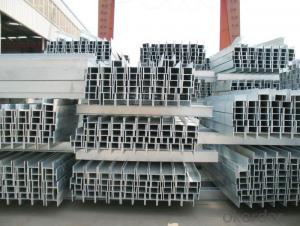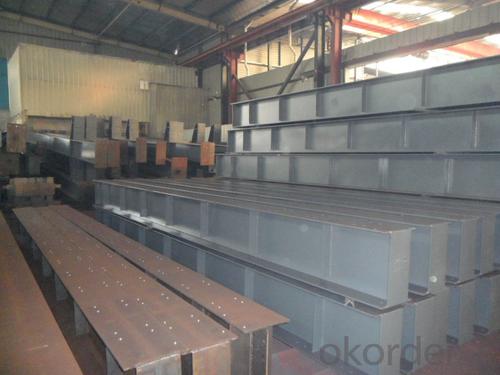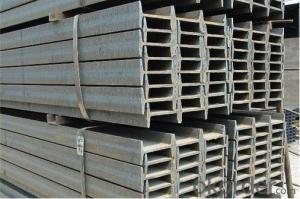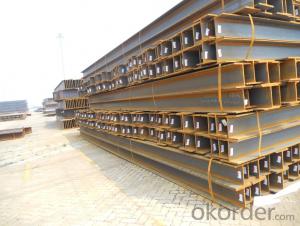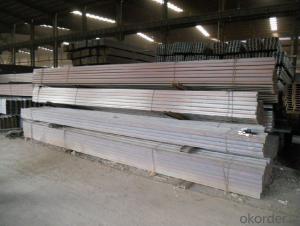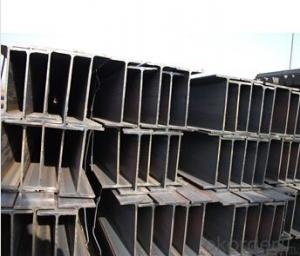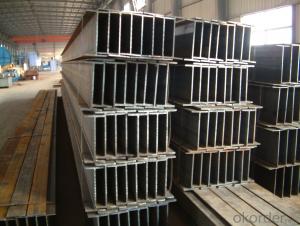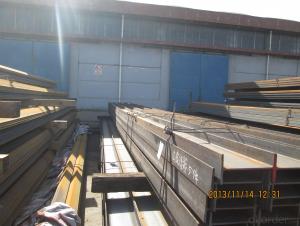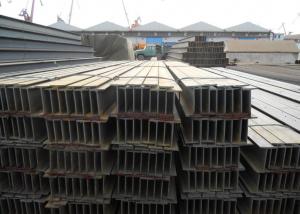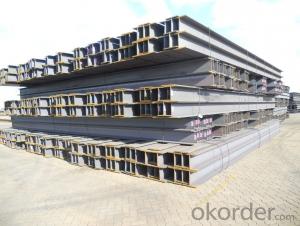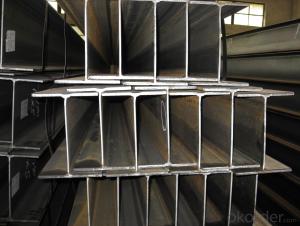Carbon steel H BEAM for construction GBQ235B
- Loading Port:
- Tianjin
- Payment Terms:
- TT or LC
- Min Order Qty:
- 25 m.t.
- Supply Capability:
- 100000 m.t./month
OKorder Service Pledge
OKorder Financial Service
You Might Also Like
Product Description:
OKorder is offering carbon steel H BEAM for construction GBQ235B at great prices with worldwide shipping. Our supplier is a world-class manufacturer of steel, with our products utilized the world over. OKorder annually supplies products to European, North American and Asian markets. We provide quotations within 24 hours of receiving an inquiry and guarantee competitive prices.
Product Applications:
Carbon steel H BEAM are ideal for structural applications and are widely used in the construction of buildings and bridges, and the manufacturing, petrochemical, and transportation industries.
Product Advantages:
OKorder's H BEAM are durable, strong, and resist corrosion.
Main Product Features:
· Premium quality
· Prompt delivery & seaworthy packing (30 days after receiving deposit)
· Corrosion resistance
· Can be recycled and reused
· Mill test certification
· Professional Service
· Competitive pricing
Product Specifications:
The wing plate, the web plate, the clamping and centering device, locating device and in the proves of spot welding are controlled automatically with PLC technology; the host drive is controlled by AC frequency converter, which ensures the stable and reliable operations; the upper fixing beam is equipped with four sets of rail assistant guide on both sides to ensure the stability when using the clamping device for a long period.
Technical Parameters:
Model | Specification of web plate | Specification of wing plate | Specification of wing plate | Power | Assembling Speed | ||
Thickness | Height | Thickness | Width | 400-15000mm | 11.7kw | 0.5-6m/min | |
Z15/ZLJ15 | 32mm | 200-1500mm | 40mm | 200-800mm | |||
Z18/ZLJ18 | 200-1800mm | ||||||
Z20/ZLJ20 | 200-2000mm | ||||||
FAQ:
Q1: How do we guarantee the quality of our products?
A1: We have established an advanced quality management system which conducts strict quality tests at every step, from raw materials to the final product. At the same time, we provide extensive follow-up service assurances as required.
Q2: What makes stainless steel stainless?
A2: Stainless steel must contain at least 10.5 % chromium. It is this element that reacts with the oxygen in the air to form a complex chrome-oxide surface layer that is invisible but strong enough to prevent further oxygen from "staining" (rusting) the surface. Higher levels of chromium and the addition of other alloying elements such as nickel and molybdenum enhance this surface layer and improve the corrosion resistance of the stainless material.
Images:

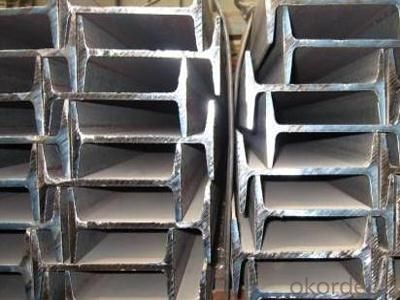
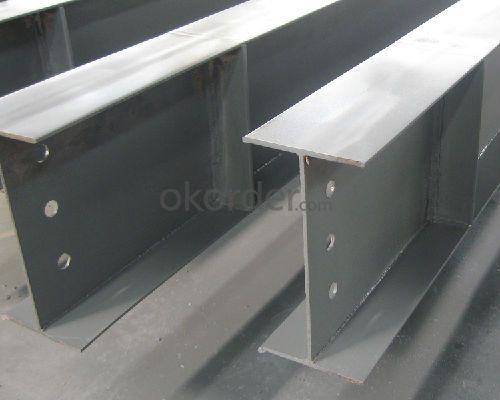
- Q: What are the different sizes and dimensions available for steel H-beams?
- Various construction and engineering applications can be accommodated by a wide range of sizes and dimensions of steel H-beams. The manufacturer and project specifications determine the specific sizes and dimensions of steel H-beams, which can vary. Steel H-beams are typically characterized by their depth, width, and weight per unit length. The depth of the H-beam refers to the height of its web, while the flange width signifies the width. The weight per unit length indicates the beam's weight per unit length, commonly measured in pounds per foot or kilograms per meter. Steel H-beams commonly come in sizes with a depth ranging from 4 inches to 36 inches and a width ranging from 5 inches to 12 inches. However, manufacturers may offer larger or smaller sizes. The weight per unit length of steel H-beams greatly varies based on the beam's size and grade. For instance, a 10-inch by 6-inch steel H-beam may weigh approximately 15 pounds per foot, whereas a 12-inch by 12-inch H-beam can weigh up to 90 pounds per foot. It is important to consider that the availability of specific sizes and dimensions may differ depending on the market and manufacturer. Some manufacturers may provide customized sizes and dimensions to meet specific project requirements. For more precise information on the available sizes and dimensions of steel H-beams, it is advisable to consult a structural engineer or contact steel suppliers.
- Q: How do steel H-beams perform in terms of impact resistance?
- The excellent impact resistance of Steel H-beams is well-known. Their structural design, characterized by wide flanges and a vertical web, ensures high durability and strength when exposed to impact forces. This feature makes them particularly suitable for applications where heavy loads or potential impacts are a concern, such as in construction projects or industrial settings. The wide flanges of H-beams distribute the impact load across a larger area, minimizing concentrated stress points and preventing failure. Moreover, the vertical web provides added rigidity and stability, enhancing the overall resistance of the beam against impacts. Additionally, steel possesses inherent toughness and resilience as a material, enabling it to absorb and dissipate energy from impacts effectively. Steel H-beams are often manufactured using top-quality structural steel, further enhancing their impact resistance properties. To summarize, the structural design of steel H-beams, combined with the material properties of steel, results in excellent impact resistance. They can withstand heavy loads and potential impacts, making them a dependable choice for a variety of applications that require structural strength and durability.
- Q: What are the different types of connections used for steel H-beams in multi-story buildings?
- There are several types of connections commonly used for steel H-beams in multi-story buildings. Some of these include bolted connections, welded connections, and composite connections. Bolted connections involve using bolts and nuts to join the beams together, providing flexibility and ease of installation. Welded connections involve melting and fusing the beams together using heat, creating a strong and rigid connection. Composite connections combine both bolted and welded connections, utilizing the advantages of both methods to achieve optimal strength and performance. The choice of connection type depends on various factors, such as design requirements, structural loadings, and construction methods.
- Q: Are steel H-beams suitable for use in coastal areas?
- Indeed, steel H-beams prove to be a fitting choice for implementation in coastal regions. The exceptional resistance of steel, particularly when it comes to top-grade stainless steel, towards corrosion renders it a suitable material for employment in coastal settings where the likelihood of exposure to saltwater and humidity is heightened. Steel H-beams find widespread application in coastal areas for a variety of construction purposes such as bridges, piers, and marine structures due to their commendable strength, enduring nature, and capacity to withstand corrosion. Furthermore, steel H-beams exhibit the ability to endure the formidable winds and harsh climatic conditions often encountered in coastal regions, thus establishing themselves as a dependable option for construction ventures in these areas.
- Q: How do steel H-beams provide structural support?
- Steel H-beams provide structural support by distributing the load evenly across their horizontal flanges and transferring it to the vertical web, which in turn transfers the load to the supporting columns or walls. This design allows for increased strength and stability, making H-beams an ideal choice for supporting heavy loads in various construction applications.
- Q: Are steel H-beams resistant to fire?
- Yes, steel H-beams are highly resistant to fire. Due to their high melting point and excellent structural integrity, steel H-beams can withstand high temperatures and maintain their strength even during a fire. This makes them a popular choice for structural support in buildings and other fire-prone environments.
- Q: What are the limitations of using steel H-beams?
- There are several limitations associated with using steel H-beams. Firstly, steel H-beams are heavy and bulky, which can make transportation and handling difficult. Their weight also makes them more expensive to transport, especially over long distances. Additionally, the size and weight of steel H-beams may require specialized equipment and infrastructure for installation, which can further increase costs. Secondly, steel H-beams have limited flexibility in terms of design and shape. They are typically manufactured in standard sizes and lengths, which may not always align with specific project requirements. This limitation can result in additional cutting, welding, or modification, adding both time and cost to the construction process. Thirdly, steel H-beams are susceptible to corrosion and require regular maintenance to prevent rusting. Exposure to moisture, chemicals, and environmental elements can weaken the structural integrity of the beams over time, reducing their lifespan and necessitating repairs or replacements. Furthermore, steel H-beams have lower resistance to fire compared to other building materials such as concrete. In the event of a fire, the steel beams can lose their strength and structural stability, potentially compromising the safety of the structure. Lastly, steel H-beams have a relatively high carbon footprint due to the energy-intensive processes involved in their production. The extraction of raw materials, such as iron ore and coal, and the subsequent manufacturing processes contribute to greenhouse gas emissions and environmental degradation. In conclusion, while steel H-beams offer excellent load-bearing capacity and structural strength, they come with limitations such as weight, inflexibility in design, susceptibility to corrosion, reduced fire resistance, and a high carbon footprint. These factors need to be carefully considered when choosing steel H-beams as a construction material.
- Q: What are the considerations for selecting the appropriate spacing of steel H-beams?
- When selecting the appropriate spacing of steel H-beams, there are several considerations to take into account. Firstly, the load-bearing capacity of the beams must be considered in relation to the anticipated loads and forces they will be subjected to. This includes both the dead loads (the weight of the structure itself) and live loads (such as the weight of occupants, furniture, or equipment). Secondly, the span of the beams plays a crucial role in determining the spacing. Longer spans typically require closer spacing to ensure sufficient support and prevent excessive deflection or sagging. Additionally, the type and thickness of the floor or roof system being supported should be considered in conjunction with the beam spacing to ensure adequate structural integrity. Furthermore, local building codes and regulations may stipulate specific requirements for beam spacing based on factors like building height, occupancy type, and seismic considerations. It is important to adhere to these guidelines to ensure compliance and safety. Lastly, cost and efficiency considerations should also be taken into account. Optimizing the spacing of steel H-beams can help minimize material use, reduce construction costs, and streamline the overall structural design. Overall, when selecting the appropriate spacing of steel H-beams, it is crucial to consider the load-bearing capacity, span, floor or roof system, building codes, and cost-efficiency factors to ensure a safe and structurally sound construction.
- Q: What are the different types of steel H-beam connections used in retail buildings?
- In retail buildings, various types of steel H-beam connections are used to ensure structural integrity and stability. Some of the commonly used connections are: 1. Welded Connection: This is the most commonly used connection in retail buildings. It involves welding the flange of one H-beam to the web of another H-beam, creating a strong bond. Welded connections are known for their high strength and durability. 2. Bolted Connection: Bolted connections involve using bolts and nuts to connect the flanges of two H-beams together. This type of connection offers flexibility as it allows for easy disassembly and reassembly if required. Bolted connections are also cost-effective and can be used in areas where welding is not preferred. 3. Gusset Plate Connection: In this type of connection, a gusset plate is used to connect the flanges of two H-beams. The gusset plate is typically made of steel and is bolted or welded to the flanges. This connection adds extra strength and stability to the structure. 4. Moment Connection: Moment connections are used in areas where high bending moments are expected. These connections provide rotational stiffness and transfer moments from one H-beam to another, ensuring the overall stability of the structure. 5. Shear Connection: Shear connections are used to transfer shear forces between H-beams. These connections involve using bolts or welds to join the webs of two H-beams together. Shear connections are essential for ensuring the overall stability and load-bearing capacity of the structure. 6. Bracing Connection: Bracing connections are used to provide additional lateral support to the structure. They involve connecting diagonal braces to the H-beams using bolts or welds. Bracing connections help resist lateral forces such as wind or seismic loads, enhancing the overall stability and safety of the retail building. It is important to consult with structural engineers and adhere to local building codes and regulations when selecting and designing H-beam connections for retail buildings. The type of connection used will depend on factors such as the structural requirements, architectural design, and the specific loads acting on the structure.
- Q: Are steel H-beams susceptible to corrosion?
- Indeed, corrosion can affect steel H-beams. Steel, deriving mainly from iron, has a tendency to oxidize when exposed to moisture and oxygen. This oxidation results in the creation of iron oxide, commonly referred to as rust. Corrosion can manifest on both the surface and interior of the H-beams if moisture becomes trapped inside. Nevertheless, susceptibility to corrosion can be lessened through diverse preventive actions like the application of protective coatings, galvanization, or the employment of stainless steel H-beams. Consistent maintenance and inspections are also crucial in promptly detecting and addressing any indications of corrosion.
Send your message to us
Carbon steel H BEAM for construction GBQ235B
- Loading Port:
- Tianjin
- Payment Terms:
- TT or LC
- Min Order Qty:
- 25 m.t.
- Supply Capability:
- 100000 m.t./month
OKorder Service Pledge
OKorder Financial Service
Similar products
Hot products
Hot Searches
Related keywords
